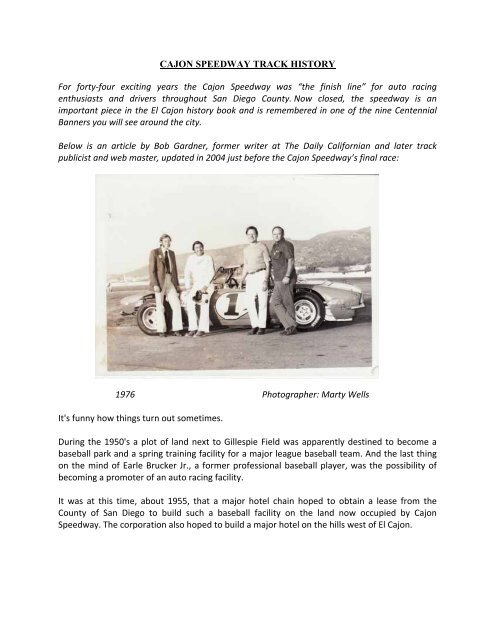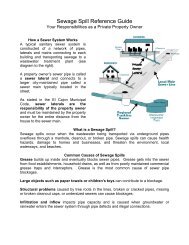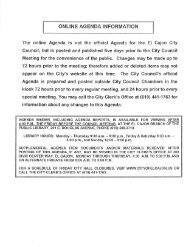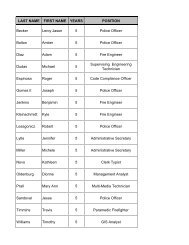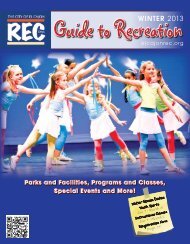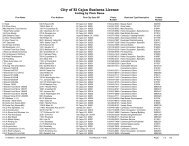CAJON SPEEDWAY TRACK HISTORY For forty ... - City of El Cajon
CAJON SPEEDWAY TRACK HISTORY For forty ... - City of El Cajon
CAJON SPEEDWAY TRACK HISTORY For forty ... - City of El Cajon
Create successful ePaper yourself
Turn your PDF publications into a flip-book with our unique Google optimized e-Paper software.
<strong>CAJON</strong> <strong>SPEEDWAY</strong> <strong>TRACK</strong> <strong>HISTORY</strong><br />
<strong>For</strong> <strong>forty</strong>‐four exciting years the <strong>Cajon</strong> Speedway was “the finish line” for auto racing<br />
enthusiasts and drivers throughout San Diego County. Now closed, the speedway is an<br />
important piece in the <strong>El</strong> <strong>Cajon</strong> history book and is remembered in one <strong>of</strong> the nine Centennial<br />
Banners you will see around the city.<br />
Below is an article by Bob Gardner, former writer at The Daily Californian and later track<br />
publicist and web master, updated in 2004 just before the <strong>Cajon</strong> Speedway’s final race:<br />
1976 Photographer: Marty Wells<br />
It's funny how things turn out sometimes.<br />
During the 1950's a plot <strong>of</strong> land next to Gillespie Field was apparently destined to become a<br />
baseball park and a spring training facility for a major league baseball team. And the last thing<br />
on the mind <strong>of</strong> Earle Brucker Jr., a former pr<strong>of</strong>essional baseball player, was the possibility <strong>of</strong><br />
becoming a promoter <strong>of</strong> an auto racing facility.<br />
It was at this time, about 1955, that a major hotel chain hoped to obtain a lease from the<br />
County <strong>of</strong> San Diego to build such a baseball facility on the land now occupied by <strong>Cajon</strong><br />
Speedway. The corporation also hoped to build a major hotel on the hills west <strong>of</strong> <strong>El</strong> <strong>Cajon</strong>.
Left to right: Lance Onnen (President <strong>of</strong> <strong>El</strong> <strong>Cajon</strong> Valley Jaycees), Pat McIntyre (1972,<br />
1973, 1975, 1976, 1977 <strong>El</strong> <strong>Cajon</strong> Stock Car Racing Assn super stock champion, Warren<br />
Norris (1976 <strong>El</strong> <strong>Cajon</strong> Stock Car Racing Assn President), Earle Brucker Jr. (<strong>Cajon</strong><br />
Speedway track promoter).<br />
But a change in the laws <strong>of</strong> the State <strong>of</strong> California forced the hotel chain to abandon its idea.<br />
California invented a new tax, the possessory interest tax, which allowed local governments to<br />
collect taxes on lands which they previously had leased tax free.<br />
With the hotel chain out <strong>of</strong> the picture, Earle Brucker Sr. decided to go it on his own, got the<br />
lease, and put in a stadium.<br />
Year: 1970<br />
Photographer: Doug Wharton<br />
“Smilin Ed” Hale was no doubt the most popular <strong>of</strong> all the fan favorites at <strong>Cajon</strong><br />
Speedway during its 44 years <strong>of</strong> operation. Hale won track championships in several<br />
divisions and was the all-time leading main event winner. He earned his nickname by his<br />
ever-present smile on his face. Sadly Hale passed away in 2005, almost one year after<br />
the track’s final race.<br />
1970 Photographer: Doug Wharton<br />
“Smilin Ed” Hale was no doubt the most popular <strong>of</strong> all the fan favorites at <strong>Cajon</strong> Speedway<br />
during its 44 years <strong>of</strong> operation. Hale won track championships in several divisions and was the
all‐time leading main event winner. He earned his nickname by his ever‐present smile on his<br />
face. Sadly Hale passed away in 2005, almost one year after the track’s final race.<br />
"At the time the idea was still to build a ballpark," Brucker Jr. recalls. "Then after we got it built,<br />
the baseball team (the Detroit Tigers) decided to go elsewhere because they could get more.<br />
Since the high schools around here didn't have anywhere to play night football and since we<br />
were committed to put in some lights, we converted the baseball field into a football stadium."<br />
"After the first year <strong>of</strong> football, a motorcycle track was put in around the field. The money we<br />
got from the motorcycles was the only income we had other than the minimal amount we got<br />
from the high schools.”<br />
1961 Photographer: Bob Hardee<br />
<strong>Cajon</strong> Speedway opened as the home <strong>of</strong> the San Diego Racing Assn modified sportsman in 1961<br />
after racing at Balboa Stadium in downtown San Diego ceased. Here Rip Erikson (10), the 1961<br />
champion, edges out Glen Hoagland (5) for the victory. Two <strong>of</strong> Hoagland’s sons (Joe and Bill)
and Hoagland’s daughter (Vicki) would also end up racing at <strong>Cajon</strong>. Bill Hoagland would become<br />
the 1990 pony stock champion at <strong>Cajon</strong>.<br />
And so by 1960 it seemed as if County Stadium, originally planned as a baseball facility, was<br />
destined to remain a high school football stadium and a motorcycle race track.<br />
But then over the winter <strong>of</strong> 1960‐1961, a weird series <strong>of</strong> events combined to lead County<br />
Stadium into becoming <strong>Cajon</strong> Speedway. Since about 1937 auto racing in San Diego County had<br />
taken place on several tracks around the county, but the most successful occurred in Balboa<br />
Stadium. In late 1960 it became obvious that the Los Angeles Chargers were moving to San<br />
Diego and would use Balboa Stadium as their facility. Tom Haynes and Frank Guthrie, the auto<br />
racing promoters in the stadium, announced plans to build a new 1/2 mile dirt oval on Kearny<br />
Mesa.<br />
But that track was never built. In early 1961 it looked as if auto racing in San Diego County was<br />
going to be without a home.<br />
But Tom Jackman, the man most responsible for the <strong>El</strong> <strong>Cajon</strong> Industrial Park and also owner <strong>of</strong><br />
one <strong>of</strong> the top racing machines in the San Diego Racing Association, approached Earle Brucker<br />
Sr. with the idea <strong>of</strong> constructing a 1/4 mile dirt oval at County Stadium.<br />
"Jackman talked to my father and they were ready to build a race track," Brucker Jr. recounts.<br />
"But they didn't have anyone to run it. One night I got a phone call from my father. I was told I<br />
was going to run it."<br />
The rest is history.<br />
1964 ` Photographer: Bob Hardee
The modified sportsman <strong>of</strong> Jim Culbert (60) flips spectacularly in the south turn <strong>of</strong> <strong>Cajon</strong><br />
Speedway. Also pictured are Rosie Roussel (79), Don Ray (1), and Harris Mills (21). Culbert was<br />
uninjured despite the wild ride.<br />
Opening night for <strong>Cajon</strong> Speedway was July 15, 1961 just eleven days after Balboa Stadium<br />
closed its doors on racing. The modifieds <strong>of</strong> SDRA were the featured attraction that first year.<br />
Less than a year later a group <strong>of</strong> guys met in <strong>El</strong> <strong>Cajon</strong> and formed the Speedway Racing<br />
Association to sanction stock car racing. They planned to keep the cost <strong>of</strong> building and<br />
maintaining a car down by allowing anyone to claim a car after the races for $150. But by 1963<br />
the claiming stocks were on their way out and were replaced by faster and more expensive<br />
super stocks. Motorcycle racing still continued for a time at the facility.<br />
The oval track was enlarged from 1/4 mile to 3/8 mile for the 1964 season and was paved two<br />
years later.<br />
1978 Photographer: Marty Wells
Here are three <strong>of</strong> the top drivers during the super stock era at <strong>Cajon</strong> Speedway. Mike Hageman<br />
(2) leads Ron Esau (3) and Gary Crossland (4) in the middle <strong>of</strong> the third and fourth turns at the<br />
3/8 mile paved oval. Esau was the 1978 titlest. Hageman won three championships – 1979,<br />
1980, and 1986. Having finished second in points four times (1974, 1978, 1980, 1981) Crossland<br />
no doubt was “the best driver who never won a championship”.<br />
After several seasons the modifieds <strong>of</strong> SDRA gradually lost their following as the super stocks<br />
gained in popularity. In 1971 the super stocks became the sole tenants except for an occasional<br />
sprint car or midget show. <strong>Cajon</strong> Speedway ran but one race in 1972 as the county<br />
unsuccessfully sought to alter the terms <strong>of</strong> the lease.<br />
So on April 28, 1973 the super stocks returned to action on the Gillespie Field track after<br />
competing the previous year on the 1/2 mile dirt South Bay Park Speedway on Otay Mesa. The<br />
middle <strong>of</strong> the 1970's were the glory days for <strong>Cajon</strong> Speedway and the <strong>El</strong> <strong>Cajon</strong> Stock Car Racing<br />
Association as nearly 100 super stocks jammed the pits each Saturday night and competition<br />
was exceptionally tight. But that passed. By the mid‐1980's the super stock fields were thinning<br />
due to escalating costs and they too became history at the end <strong>of</strong> the 1988 season. They were<br />
replaced by the sportsman stocks, which was designed to be a more economical form <strong>of</strong> racing.<br />
That division is still the premier class on the track today, but shares the oval with the Grand<br />
American modifieds, street stocks, pony stocks, bomber stocks, and factory stocks.<br />
<strong>Cajon</strong> Speedway joined the NASCAR alliance prior to 1986 and today is one <strong>of</strong> about 100 short<br />
tracks across the nation participating in the weekly NASCAR Weekly Racing Series presented by<br />
Dodge.<br />
Since 1961 more than 3,965,000 fans have attended the racing events at <strong>Cajon</strong> Speedway,<br />
making the track one <strong>of</strong> the most successful and longest running race tracks on the west coast.<br />
There have been 1299 nights <strong>of</strong> oval track racing during those 43 years with 595 different<br />
drivers visiting victory lane following the 3195 main events. The Brucker clan continues to run<br />
the facility. Over the years Earle Brucker Jr. turned over the daily management chores to sons<br />
Steve and Kevin. Kevin is now responsible for the track's operation following the death <strong>of</strong> Steve<br />
Brucker, who was murdered in his home in April 2003. In 2003 nearly 67,000 fans attended the<br />
races during the season, an average <strong>of</strong> about 2560 per night.<br />
It certainly can be said the proposed baseball facility has come a long way.<br />
Thank you to Bob Gardner for providing this information and accompanying photos.


